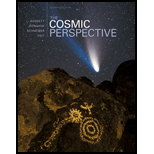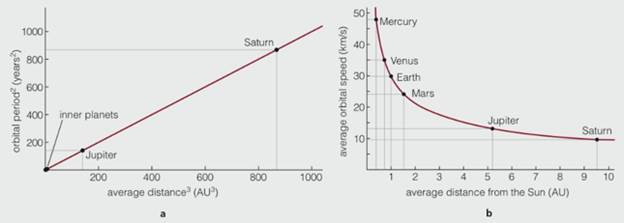
The Cosmic Perspective
7th Edition
ISBN: 9780321839558
Author: Jeffrey O. Bennett, Megan O. Donahue, Nicholas Schneider, Mark Voit
Publisher: Addison-Wesley
expand_more
expand_more
format_list_bulleted
Textbook Question
Chapter 3, Problem 5VSC
Use the following questions to check your understanding of some of the many types of visual information used in astronomy. For additional practice, try the Chapter 3 Visual Quiz at MasteringAstronomy®.

Study the two graphs above, based on Figure 3.19. Use the information in the graphs to answer the following questions.
5. On graph a, you can see Kepler's third law (p2= a3) from the fact that
a. the data fall on a straight line.
b. the axes are labeled with values for p2and a3.
c. the planet names are labeled on the graph.
Expert Solution & Answer
Want to see the full answer?
Check out a sample textbook solution
Students have asked these similar questions
11. If all three collisions in the figure below are
totally inelastic, which brings the car of mass (m) on
the left to a halt?
I
m
II
III
m
m
ע
ע
ע
brick wall
0.5v
2m
2v
0.5m
A. I
B. II
C. III
D. I and II
E. II and III
F. I and III
G. I, II and III (all of them)
How can you tell which vowel is being produced here ( “ee,” “ah,” or “oo”)? Also, how would you be able to tell for the other vowels?
You want to fabricate a soft microfluidic chip like the one below. How would you go about
fabricating this chip knowing that you are targeting a channel with a square cross-sectional
profile of 200 μm by 200 μm. What materials and steps would you use and why? Disregard the
process to form the inlet and outlet.
Square Cross Section
Chapter 3 Solutions
The Cosmic Perspective
Ch. 3 - Prob. 1VSCCh. 3 - Use the following questions to check your...Ch. 3 - Use the following questions to check your...Ch. 3 - Use the following questions to check your...Ch. 3 - Use the following questions to check your...Ch. 3 - Prob. 6VSCCh. 3 - Prob. 7VSCCh. 3 - Prob. 1EAPCh. 3 - Why did ancient peoples study astronomy? Describe...Ch. 3 - Describe the astronomical origins of our day,...
Ch. 3 - What is a lunar calendar? How can it be kept...Ch. 3 - What do we mean by a model in science?Ch. 3 - Summarize the development of the Greek geocentric...Ch. 3 - What was the Copernican revolution, and how did it...Ch. 3 - 8. What is an ellipse? Define its foci, semimajor...Ch. 3 - 9. State and explain the meaning of each of...Ch. 3 - Describe the three hallmarks of science and how we...Ch. 3 - 11. What is the difference between a hypothesis...Ch. 3 - What is the basic idea behind astrology? Explain...Ch. 3 - Science or Nonscience? Each of the following...Ch. 3 - Science or Nonscience? Each of the following...Ch. 3 - Science or Nonscience?
Each of the following...Ch. 3 - Science or Nonscience?
Each of the following...Ch. 3 - Science or Nonscience?
Each of the following...Ch. 3 - Science or Nonscience? Each of the following...Ch. 3 - Science or Nonscience? Each of the following...Ch. 3 - Science or Nonscience?
Each of the following...Ch. 3 - Science or Nonscience?
Each of the following...Ch. 3 - Science or Nonscience? Each of the following...Ch. 3 - In the Greek geocentric model, the retrograde...Ch. 3 - Which of the following was not a major advantage...Ch. 3 - When we say that a planet has a highly eccentric...Ch. 3 - Earth is closer to the Sun in January than in...Ch. 3 - According to Kepler’s third law, (a) Mercury...Ch. 3 - Tycho Brahe’s contribution to astronomy included...Ch. 3 - Galileo’s contribution to astronomy included (a)...Ch. 3 - Which of the following is not true about...Ch. 3 - Which of the following is not true about a...Ch. 3 - When Einstein’s theory of gravity (general...Ch. 3 - Prob. 33EAPCh. 3 - Earth’s Shape. It took thousands of years for...Ch. 3 - Prob. 35EAPCh. 3 - Prob. 36EAPCh. 3 - Prob. 37EAPCh. 3 - Prob. 38EAPCh. 3 - Prob. 39EAPCh. 3 - Prob. 40EAPCh. 3 - Prob. 41EAPCh. 3 - Prob. 42EAPCh. 3 - Prob. 43EAPCh. 3 - Prob. 44EAPCh. 3 - Be sure to show alt calculations clearly and state...Ch. 3 - Prob. 46EAPCh. 3 - Be sure to show alt calculations clearly and state...Ch. 3 - Prob. 48EAPCh. 3 - Prob. 49EAPCh. 3 - Prob. 50EAPCh. 3 - Prob. 51EAPCh. 3 - Prob. 52EAPCh. 3 - Prob. 53EAPCh. 3 - Prob. 54EAPCh. 3 - Prob. 55EAPCh. 3 - Prob. 56EAPCh. 3 - Prob. 57EAPCh. 3 - Prob. 58EAP
Knowledge Booster
Learn more about
Need a deep-dive on the concept behind this application? Look no further. Learn more about this topic, physics and related others by exploring similar questions and additional content below.Similar questions
- 1. What are the key steps involved in the fabrication of a semiconductor device. 2. You are hired by a chip manufacturing company, and you are asked to prepare a silicon wafer with the pattern below. Describe the process you would use. High Aspect Ratio Trenches Undoped Si Wafer P-doped Si 3. You would like to deposit material within a high aspect ratio trench. What approach would you use and why? 4. A person is setting up a small clean room space to carry out an outreach activity to educate high school students about patterning using photolithography. They obtained a positive photoresist, a used spin coater, a high energy light lamp for exposure and ordered a plastic transparency mask with a pattern on it to reduce cost. Upon trying this set up multiple times they find that the full resist gets developed, and they are unable to transfer the pattern onto the resist. Help them troubleshoot and find out why pattern of transfer has not been successful. 5. You are given a composite…arrow_forwardTwo complex values are z1=8 + 8i, z2=15 + 7 i. z1∗ and z2∗ are the complex conjugate values. Any complex value can be expessed in the form of a+bi=reiθ. Find r and θ for (z1-z∗2)/z1+z2∗. Find r and θ for (z1−z2∗)z1z2∗ Please show all stepsarrow_forwardAn electromagnetic wave is traveling through vacuum in the positive x direction. Its electric field vector is given by E=E0sin(kx−ωt)j^,where j^ is the unit vector in the y direction. If B0 is the amplitude of the magnetic field vector, find the complete expression for the magnetic field vector B→ of the wave. What is the Poynting vector S(x,t), that is, the power per unit area associated with the electromagnetic wave described in the problem introduction? Give your answer in terms of some or all of the variables E0, B0, k, x, ω, t, and μ0. Specify the direction of the Poynting vector using the unit vectors i^, j^, and k^ as appropriate. Please explain all stepsarrow_forward
- Another worker is performing a task with an RWL of only 9 kg and is lifting 18 kg, giving him an LI of 2.0 (high risk). Questions:What is the primary issue according to NIOSH?Name two factors of the RWL that could be improved to reduce risk.If the horizontal distance is reduced from 50 cm to 30 cm, how does the HM change and what effect would it have?arrow_forwardTwo complex values are z1=8 + 8i, z2=15 + 7 i. z1∗ and z2∗ are the complex conjugate values. Any complex value can be expessed in the form of a+bi=reiθ. Find r and θ for z1z2∗. Find r and θ for z1/z2∗? Find r and θ for (z1−z2)∗/z1+z2∗. Find r and θ for (z1−z2)∗/z1z2∗ Please explain all steps, Thank youarrow_forwardAn ac series circuit consists of a voltage source of frequency 60 Hz and voltage amplitude V, a 505-Ω resistor, and a capacitor of capacitance 7.2 μF. What must be the source voltage amplitude V for the average electrical power consumed in the resistor to be 236 W? There is no inductance in the circuit.arrow_forward
- An L−R−C series circuit has R= 280 Ω . At the frequency of the source, the inductor has reactance XLL= 905 Ω and the capacitor has reactance XC= 485 Ω . The amplitude of the voltage across the inductor is 445 V . What is the amplitude of the voltage across the resistor and the capacitor? What is the voltage amplitude of the source? What is the rate at which the source is delivering electrical energy to the circuit?arrow_forwardA 0.185 H inductor is connected in series with a 98.5 Ω resistor and an ac source. The voltage across the inductor is vL=−(12.5V)sin[(476rad/s)t]vL. Derive an expression for the voltage vR across the resistor. Express your answer in terms of the variables L, R, VL (amplitude of the voltage across the inductor), ω, and t. What is vR at 2.13 ms ? Please explain all stepsarrow_forwardA worker lifts a box under the following conditions:Horizontal distance (H): 30 cmInitial height (V): 60 cmVertical travel (D): 50 cmTorso rotation (A): 30°Frequency: 3 times/minute for 1 hourGrip: Good Question:What is the RWL for this task?What does this value mean in terms of occupational safety?arrow_forward
- Can someone helparrow_forwardCan someone help mearrow_forward3. Four identical small masses are connected in a flat perfect square. Rank the relative rotational inertias (IA, IB, IC) about the three axes of rotation shown. Axes A and B are in the plane of the square, and axis C is perpendicular to the plane, through mass m1. ΙΑ IB m2 m1 m3 Ic m4 (a) IAarrow_forwardarrow_back_iosSEE MORE QUESTIONSarrow_forward_ios
Recommended textbooks for you
 Stars and Galaxies (MindTap Course List)PhysicsISBN:9781337399944Author:Michael A. SeedsPublisher:Cengage Learning
Stars and Galaxies (MindTap Course List)PhysicsISBN:9781337399944Author:Michael A. SeedsPublisher:Cengage Learning Foundations of Astronomy (MindTap Course List)PhysicsISBN:9781337399920Author:Michael A. Seeds, Dana BackmanPublisher:Cengage Learning
Foundations of Astronomy (MindTap Course List)PhysicsISBN:9781337399920Author:Michael A. Seeds, Dana BackmanPublisher:Cengage Learning
 AstronomyPhysicsISBN:9781938168284Author:Andrew Fraknoi; David Morrison; Sidney C. WolffPublisher:OpenStax
AstronomyPhysicsISBN:9781938168284Author:Andrew Fraknoi; David Morrison; Sidney C. WolffPublisher:OpenStax
 Stars and GalaxiesPhysicsISBN:9781305120785Author:Michael A. Seeds, Dana BackmanPublisher:Cengage Learning
Stars and GalaxiesPhysicsISBN:9781305120785Author:Michael A. Seeds, Dana BackmanPublisher:Cengage Learning

Stars and Galaxies (MindTap Course List)
Physics
ISBN:9781337399944
Author:Michael A. Seeds
Publisher:Cengage Learning

Foundations of Astronomy (MindTap Course List)
Physics
ISBN:9781337399920
Author:Michael A. Seeds, Dana Backman
Publisher:Cengage Learning


Astronomy
Physics
ISBN:9781938168284
Author:Andrew Fraknoi; David Morrison; Sidney C. Wolff
Publisher:OpenStax


Stars and Galaxies
Physics
ISBN:9781305120785
Author:Michael A. Seeds, Dana Backman
Publisher:Cengage Learning
Time Dilation - Einstein's Theory Of Relativity Explained!; Author: Science ABC;https://www.youtube.com/watch?v=yuD34tEpRFw;License: Standard YouTube License, CC-BY